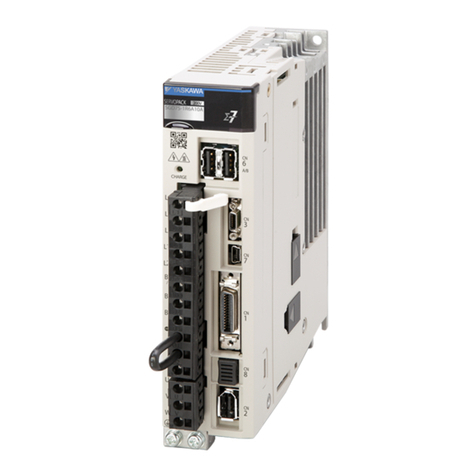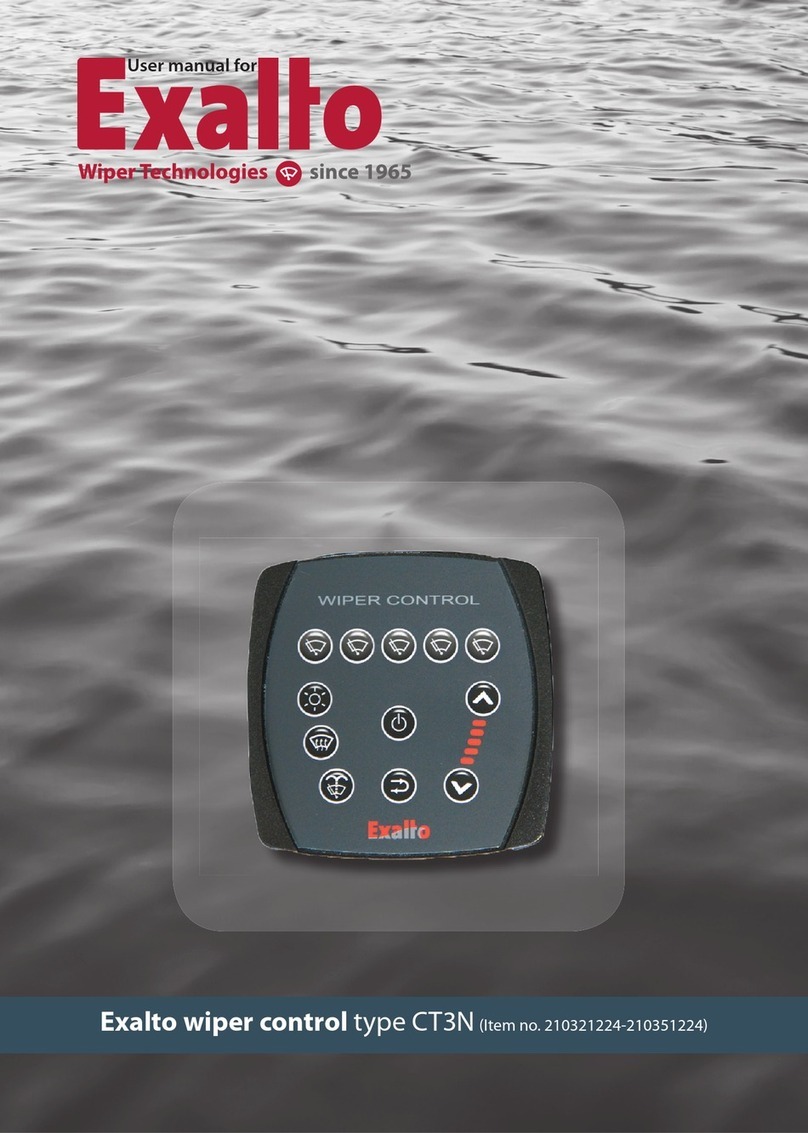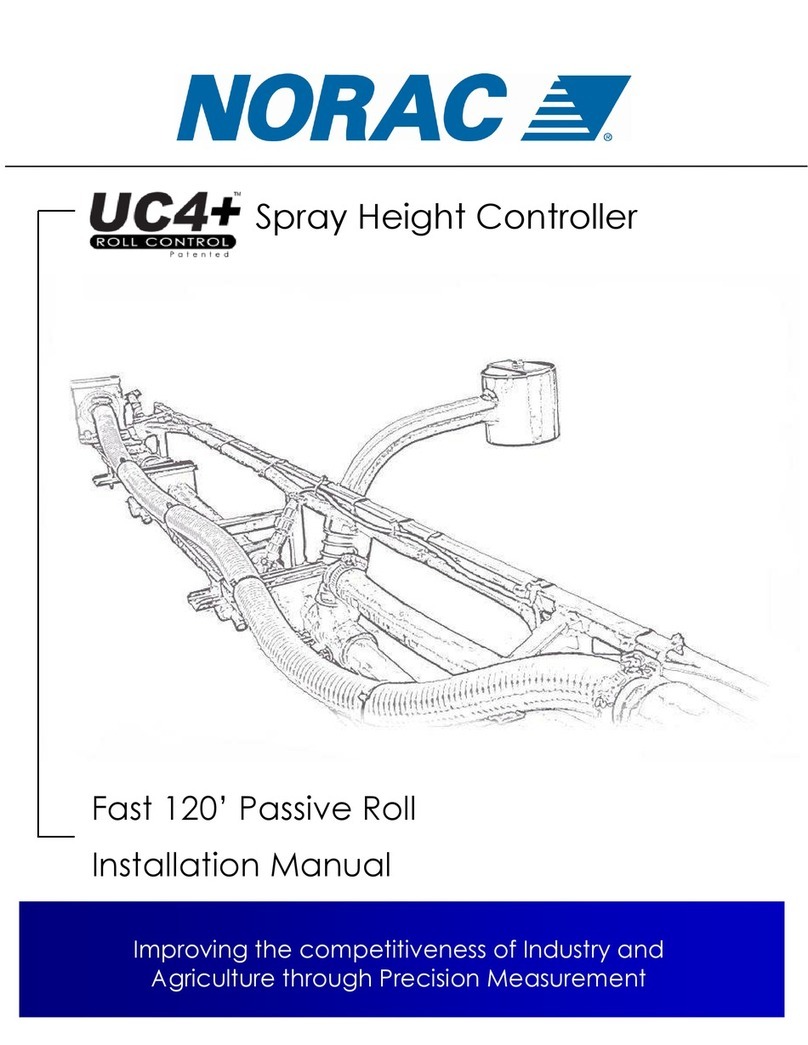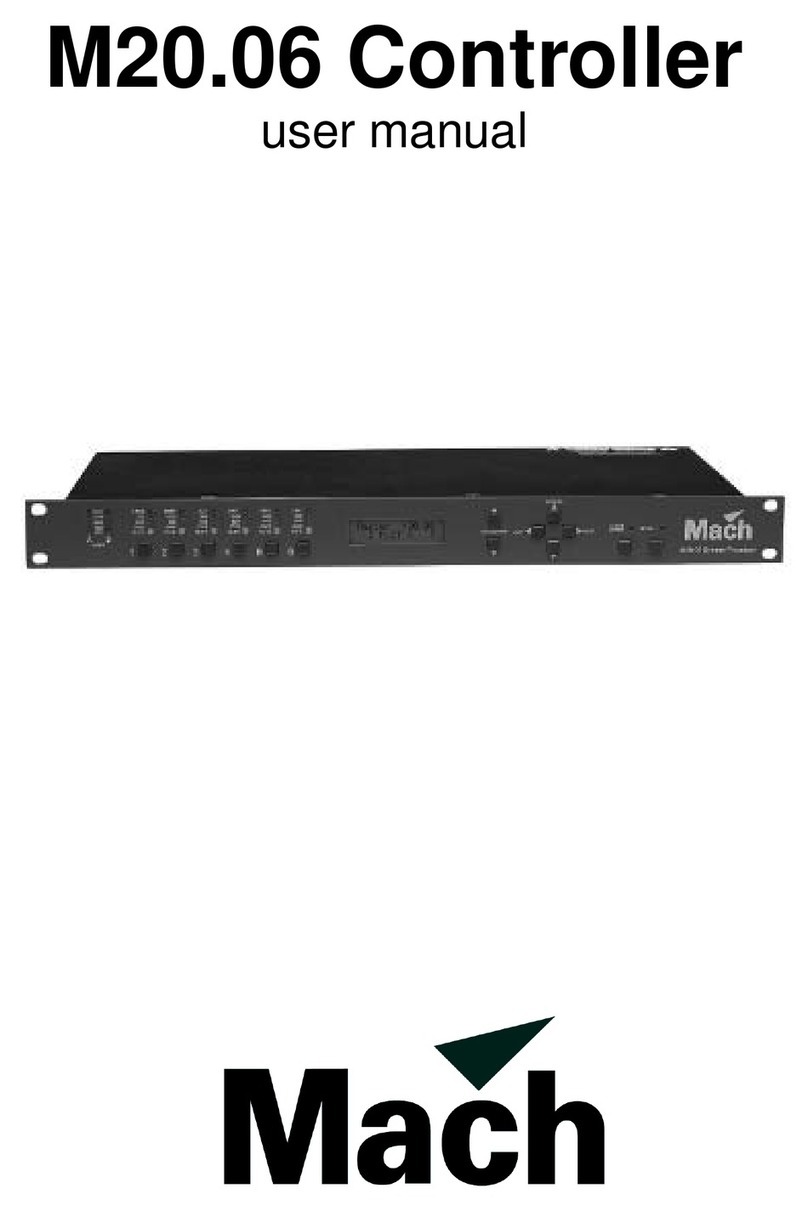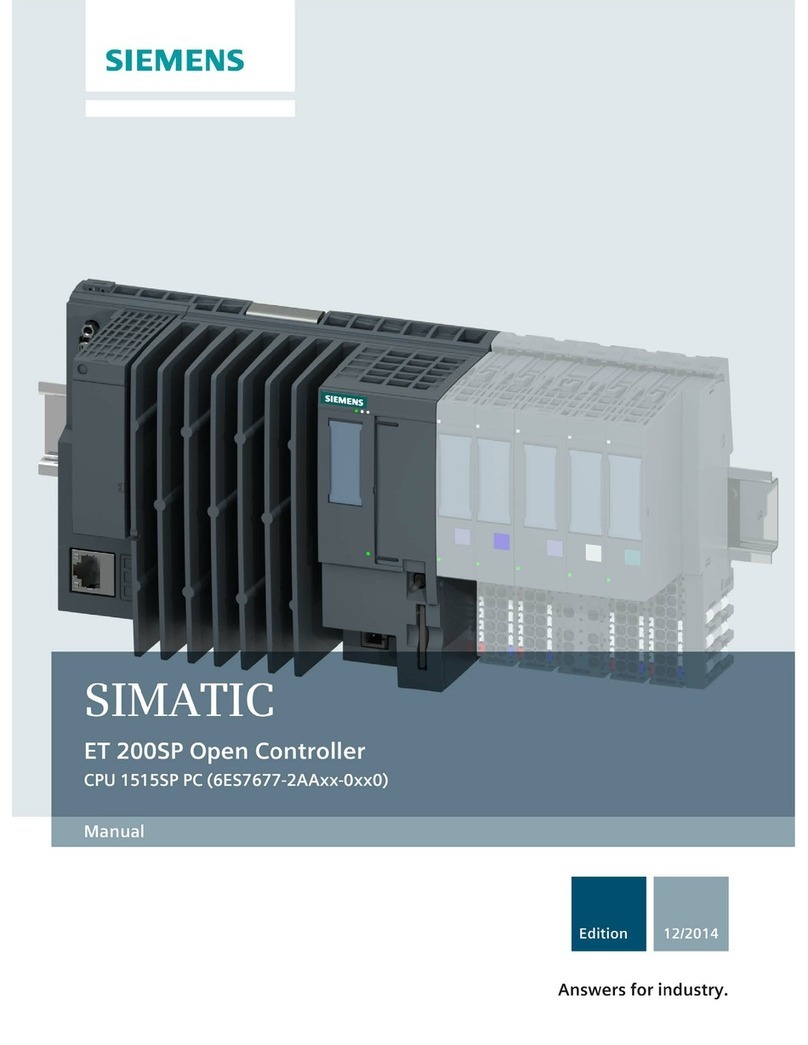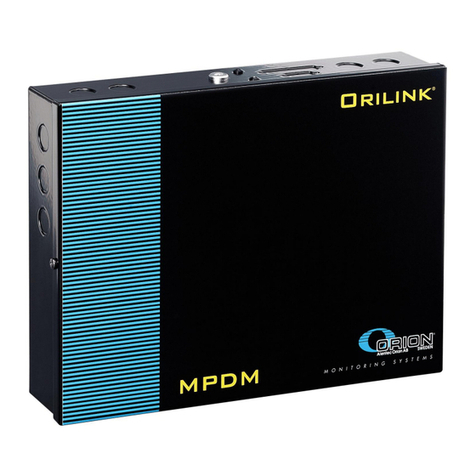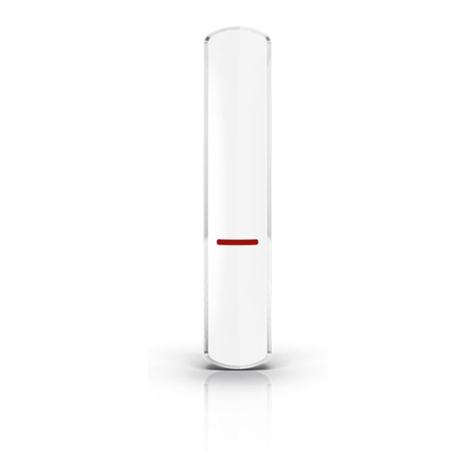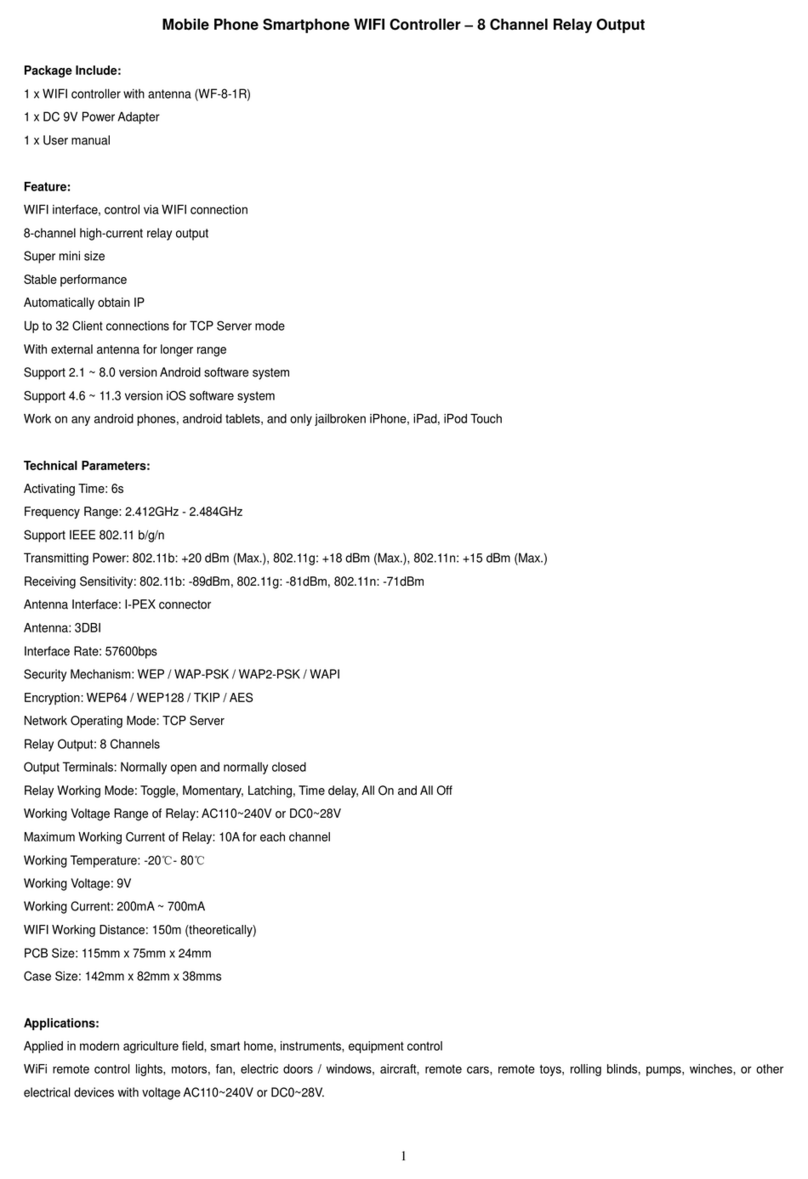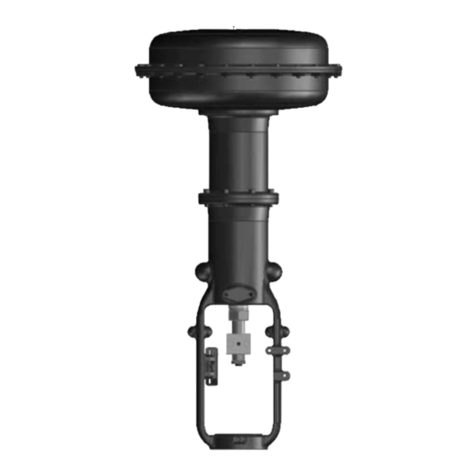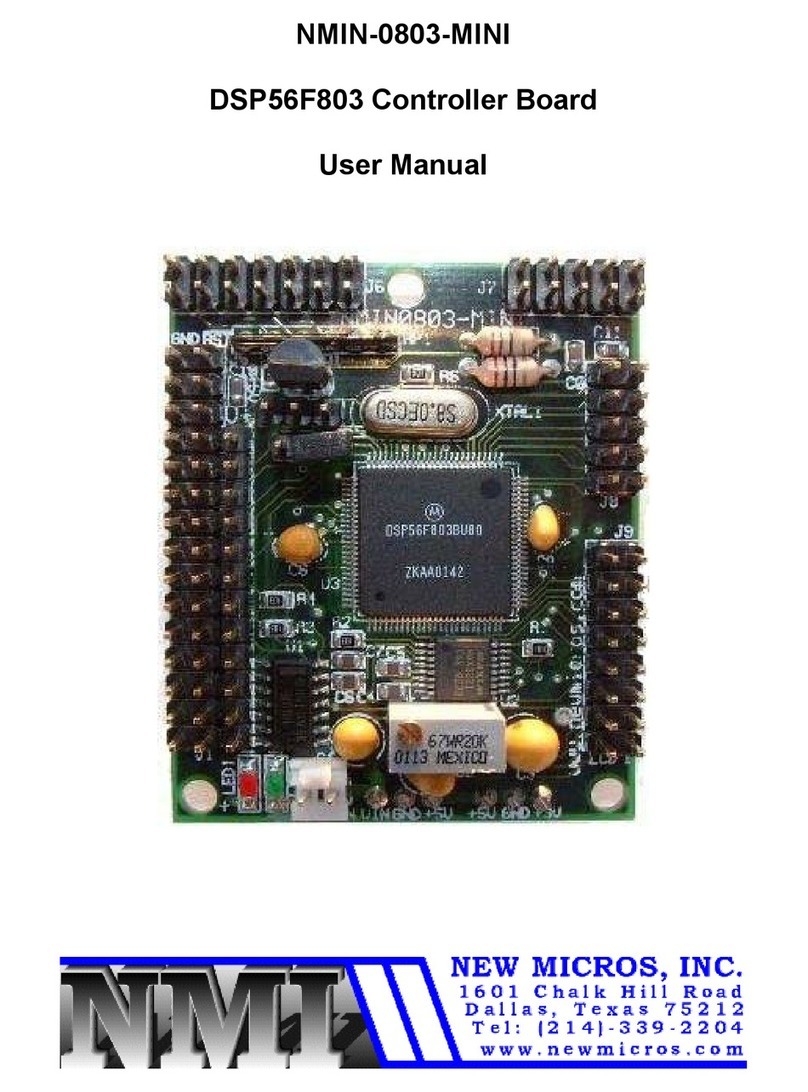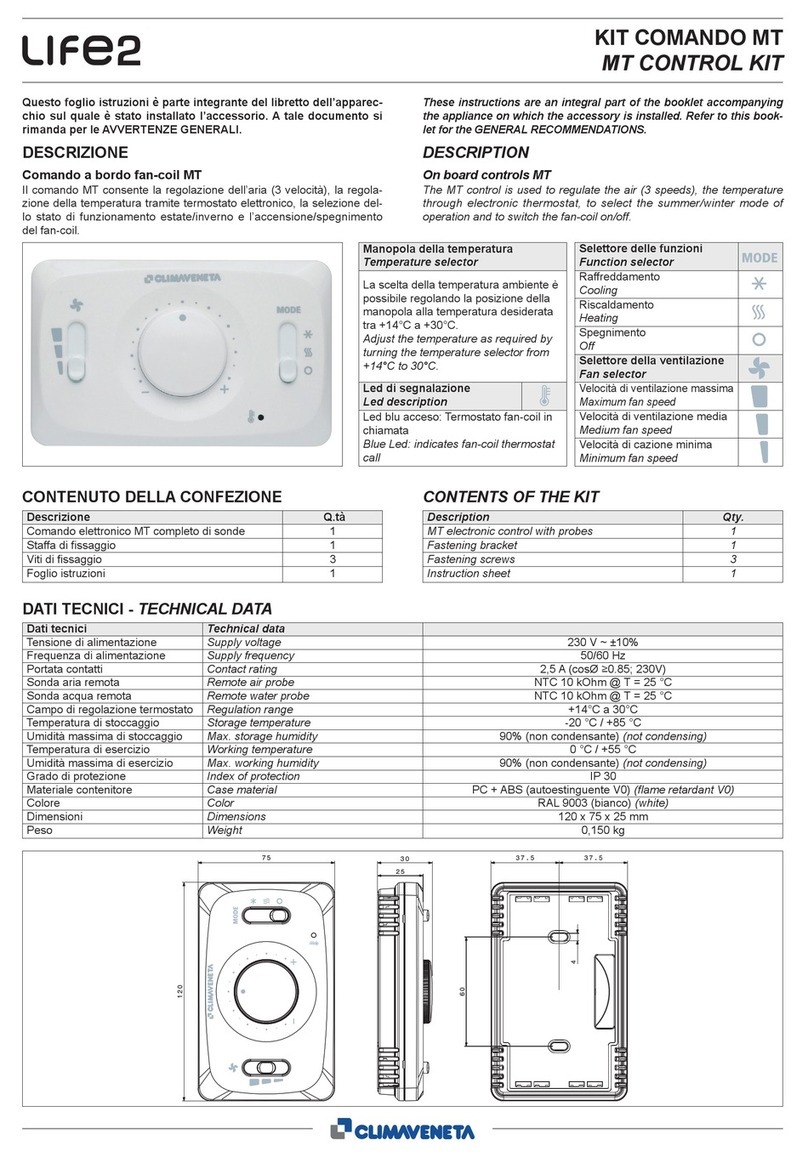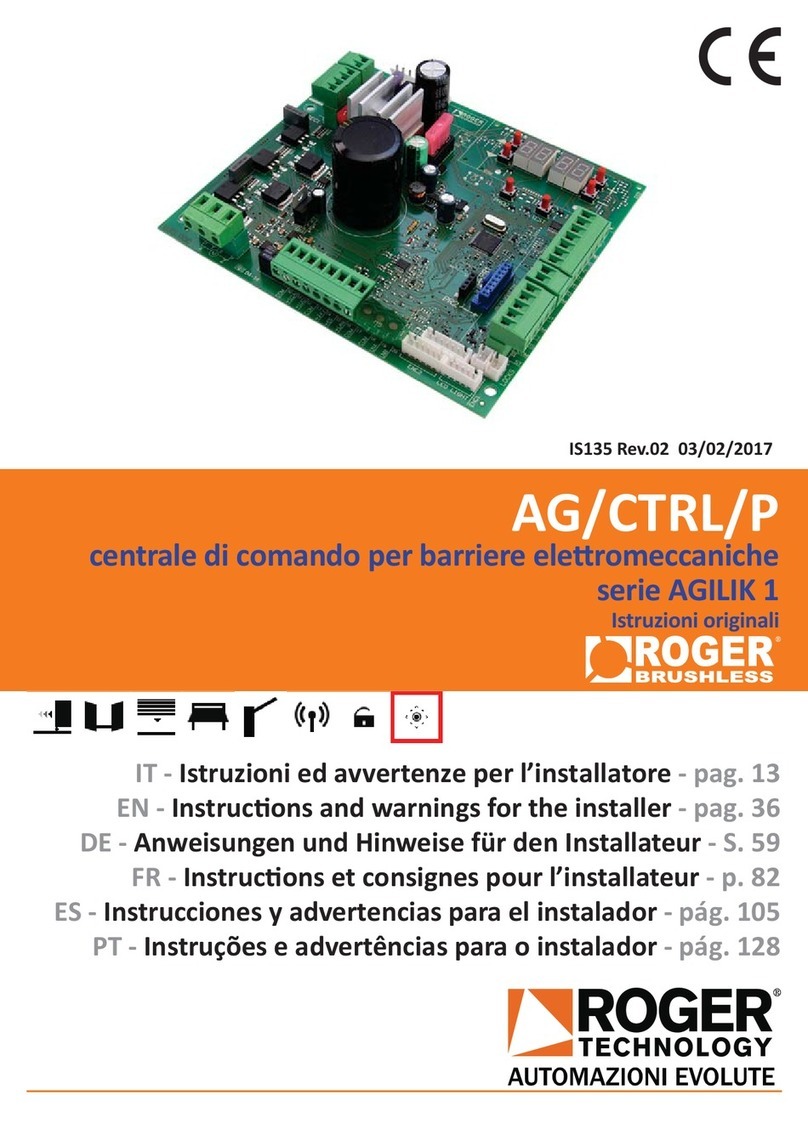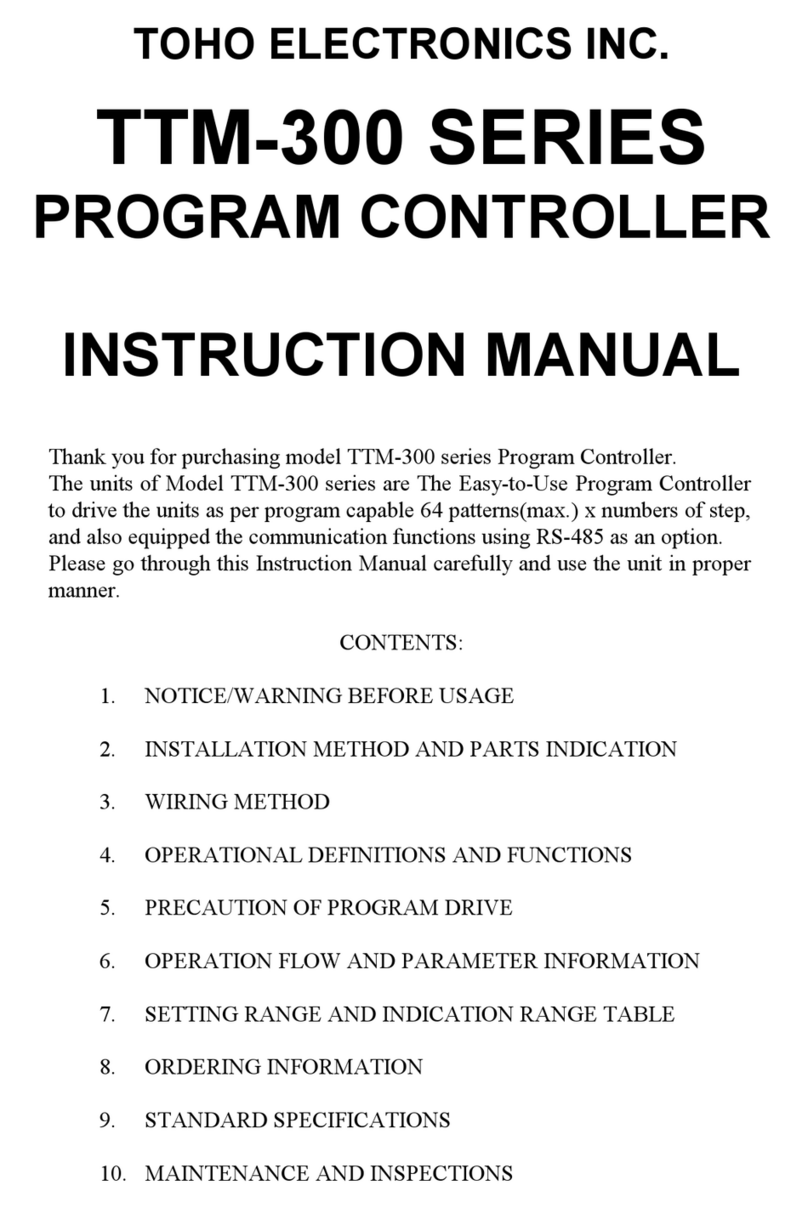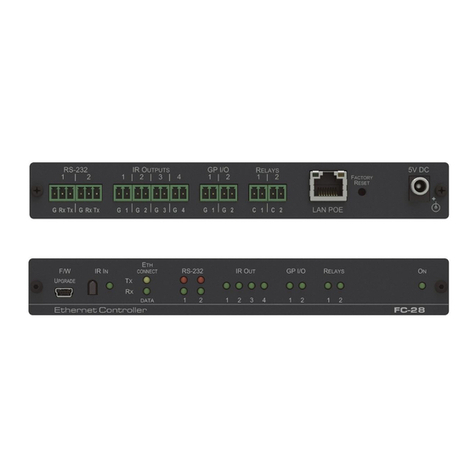GEORGE FISCHER SIGNET 9030 Intelek-Pro User manual

+GF+SIGNET 9030 Intelek-Pro
Instruction Manual
pH Controller
GEORGE FISCHER +GF+

CAUTION: Remove AC power to unit prior to
wiring input and output connections.
Important Safety Information!
Remove AC power before opening unit. Electrical
shock hazard exists

Table of
Contents
Chapter Page
1 Introduction 1
1.1 Introduction 1
1.2 Front Panel Description 2
1.3 Rear Panel Description 3
2 Installation and Operation 4
2.1 Mounting Instructions 4
2.2 Power Connections 5
2.3 Input Connections 6
2.4 2-Relay Output Connections 7
2.5 Dual Proportional Relay Connections 8
2.6 Verifying Analog Outputs 9
2.7 Analog Output Connections 10
3 System Configuration 10
3.1 Introduction 10
3.2 Calibration Menu, pH Sensor Inputs 12
3.3 Calibration Menu, Analog Inputs 13
3.4 2-Relay Operation 15
3.5 Dual Proportional Relay Operation 15
3.6 Calibration Menu, Relay Outputs 17
3.7 Calibration Menu, Analog Outputs 19
3.8 View-Only Menus 20
4 Technical Support 21
4.1 Accessing Internal Options 21
4.2 AC Power Configurations 22
4.3 Security Code Function 22
4.4 Installing Input/Output Options 23
4.5 Input Card Introduction Mode 23
4.6 Option Cards and Accessories 28
4.7 Output Card Configurations 29
4.8 Troubleshooting 30
Specifications 31
Warranty Information 33

Unpacking and Inspection
Your pH controller package includes the following
items:
•+GF+SIGNET 9030 Intelek-Pro pH Controller
• Two stainless steel mounting brackets
• Mounting Instructions w/self-adhesive template
• Panel gasket
• Instruction manual w/warranty card
Please fill out and return warranty card as soon as
possible.
Warranty Record
For your protection, record your unit's purchase
date and serial number for future reference. The
serial number decal is located on the instrument's
rear panel.
Model: +GF+SIGNET 9030 Intelek-Pro
pH Controller
Purchase Date: _______________________
Serial Number: ________________________
Purchased From: _______________________
Purchase Order Number: _______________

Chapter 1
Introduction
1.1 Introduction
Your new +GF+SIGNET 9030 Intelek-Pro pH
Controller has been specifically designed for pH
measurement process control applications. The
controller's compact 1/4 DIN enclosure (front) is
NEMA 4X/IP65 rated and ideal for installation
into instrumentation panels with limited space.
Modular "plug-in" input/output option cards allow
you to customize your pH controller to your
system's requirements. The controller's unique
"slide-out" chassis design makes option installation
fast and simple. Smart self-configuring
microprocessor based circuitry automatically
inventories installed options during power-up,
allowing you to upgrade your system in seconds
without the need for additional equipment.
The unit's front panel features a highly visible
4.5-digit (seven segment) and 8-digit (alphanu-
meric) liquid crystal display with adjustable con-
trast. Active pH, mV, temperature in °C, and
alarm relay status information is quickly accessed
at a glance. During calibration the user is
prompted with clear step-by-step instructions on the
unit's front panel display.
The +GF+SIGNET 9030 Intelek-Pro pH Controller
is fully compatible with all +GF+SIGNET pH
sensor products, yet also accepts other analog
inputs, such as 4 to 20 mA or 0 to 5 VDC etc.
1
The technical data given in
this publication is for general
information purposes only. It
implies no warranty of any
kind.

2
1.2 Front Panel Description
A) Accesses the CAL "view-only" menu B) Used in conjunction with MOD key to
access the main CAL menu
A) Accesses the OUTPUT "view-only" menu B) Used in conjunction with the
"MOD" key to access the OUTPUT calibration menu
A) Accesses the RELAY "view-only" menu B) Used in conjunction with MOD key
to access the RELAY calibration menu
A) Accesses one of three calibration menus: CAL, RELAY, OUT B) Enables a
calibration parameter for modification C) Restores a calibration parameter to
it's original value during calibration.
1. Relay An-
nunciators:
3.
5.
6.
7.
Indicate activation status of optional output "alarm" relays 1 & 2 and additional
relays 3 & 4 (proportional or on/off control)
Shows pH, mV, temperature in °C, and relay activation status information2. LCD
Display:
A) Stores a calibration value into memory after modification B) Used to
display available input/output options during normal operation.
4.
A) Displays temperature in degrees Celsius during normal operation
B) Decreases the value of a selected calibration digit
8.
Item Function
A) Displays mV during normal operation B) Increases the value of a selected
calibration digit
9.
10.
ENTER
A) Returns the unit to normal operation mode B) Selects a digit for modification
during calibration.
pH
pH CONTROLLER
ENTER MOD
CAL RELAY OUTPUT
+GF+SIGNET
2
3
4
5
6
1
7
8
9
10
pH mV
TEMP
RLY 1
RLY 2
RLY 3
RLY 4
MOD
CAL
RELAY
OUTPUT
TEMP
mV

3
1.3 Rear Panel Description
ItemFunction
90 to 132 VAC or 180 to 264 VAC system power
connection 1. AC IN
17 to 30 VDC system power connection 2. DC IN
Analog output #1 from option socket #1 (optional) 5. ANL1
Sensor input connections 6. INPUT
±5 VDC @ 1 mA power output for pH sensor pre-amp circuit 7. PRE-AMP
Serial outputs (future availability) 8. SERIAL
Analog output #2 from option socket #2 (optional) 9. ANL2
Alarm relay #1 (COM, NO, NC) contact set for external
device control (optional) 3. RLY1
Alarm relay #2 (COM, NO, NC) contact set for external
device control (optional) 4. RLY2
Proportional control relay #4 (COM, NO) contact set for
external device control (optional) 10. RLY4
Proportional control relay #3 (COM, NO) contact set for
external device control (optional) 11. RLY3
Note:
Rear terminals
accept 18 to 22 AWG
wire
1 2 3 4 5 6 7 8 9 10 11 12 13 14
15 16 17 18 19 20 21 22 23 24 25 26 27 28
CNO
RLY3 RLY4 SERIAL
Tx GND Rx
PRE-AMP
V+ V- T+ Ain ISO
INPUT
L1AC IN + GND NO C NC
RLY1DC IN NO C NC
RLY2 R+ R-
ANL1
CNO ANL2
R+ R-
11 10 9876
123 4 5
N

4
Chapter 2
Installation
and
Operation
2.1 Mounting Instructions
The +GF+SIGNET Intelek-Pro pH Controller's 1/4
DIN enclosure is specifically designed for panel
mounting. Adjustable mounting brackets allow
mounting in panels up to one inch (25 mm) thick.
An adhesive template and instructions are included
to insure proper installation.
For outdoor and/or stand alone installations the
splash-proof NEMA 4X/IP65 back cover kit is
recommended (ordered separately).
Figure 1
External dimensions
Panel Cutout Instructions
Recommended panel cutout 3.54 inch (90 mm) square. Maximum panel cutout 3.62 inch
(92 mm) square, DO NOT exceed. Use adhesive backed template (included)
5.7 in./145 mm 6 in./152 mm
7.2 in./183 mm
Mounting Clamp (included, 2 ea.)
*Optional NEMA 4X/IP65 Rear Cover
3.8 in. sq.
96 mm 3.5 in.
88 mm
Mounting Panel
Max. panel thickness = 1 in./25 mm
Panel
Gasket
SIDE VIEW
6.5 in./165 mm

15 16 17 18 19 20 21 22 23 24 25 26 27 28
L
1
N
AC IN
+ GND NO C NC
RLY1DC IN NO C NC
RLY2
R+ R-
ANL1
90 to 132 VAC
OR
180 to 264 VAC
AC Hot
AC Ground*
AC Neutral
5
2.2 Power Connections
AC Power Connections
Note: AC/DC power can be connected simultaneously,
using DC power as an uninterrupted power source.
*A direct or low impedance earth ground must be used
for optimum performance
Instructions
1. Jumper selectable for 90 to 132 OR 180 to 264
VAC operation. Confirm AC power configuration before
applying power. See section 4.2
2. *A direct or low impedance AC ground (earth
ground) MUST be used for proper operation.
3. To reduce the possibility of noise interference, AC
power lines must be isolated from signal lines.
Figure 2
AC power wiring
Note: DC power
recommended when ground
fault interruption devices
(GFI's) are used.
Figure 3
DC power wiring
L
1
N
AC IN
+ GND NO C NC
RLY1DC IN NO C NC
RLY2
R+ R-
ANL1
17 to 30 VDC @ 0.5 A
GND
15 16 17 18 19 20 21 22 23 24 25 26 27 28
*
DC Power Connections

1 2 3 4 5 6 7 8 9 10 11 12 13 14
CNO
RLY3 RLY4 SERIAL
Tx GND Rx
PRE-AMP
V+ V- T+ Ain ISO
INPUT
CNO
ANL2
R+ R-
Analog
Inputs R+
R-
OR
B
SILVER earth
ground
A
+GF+SIGNET 3-2720
pH/ORP Pre-amplifier/
Sensor System
BLUE
BLACK
RED
GREEN
WHITE
BROWN
6
2.3 Input Connections
Three input options are available, providing a
wide range of compatibility for most applications.
pH Input Card
Provides isolated pH sensor input capability,
requiring no internal configuration.
Analog Input Cards
Two analog input options available:
• Analog (iso) current, 4 to 20/0 to 20 mA
• Analog (iso) voltage, 0 to 5/0 to 10 VDC
Input ranges are software selectable, requiring no
internal configuration.
Note:
See section 4.6 for a
listing of available input cards
Figure 4A
Input Wiring
To reduce the possibility of
noise interference, separate
input lines from AC power
lines.

7
2.4 2-Relay Output Connections
The 2-Relay option provides two relays for external
device control. Each relay's contacts are rated for
5 A maximum. Both NO and NC contacts may
be used simultaneously or individually as shown.
Figure 5
2-Relay wiring
Device A is powered during
normal operation. Power is
discontinued when relay is
energized. Device B is not
powered during normal
operation. Power is applied
after relay is energized.
To reduce the possibility of
noise interference, separate
AC relay lines from input/
output lines.
Figure 4B
2-Wire Transmitter Wiring
Note:
Relay contacts are rated as 5 A @ 250 VAC or
5 A @ 30 VDC maximum resistive load.
To reduce the possibility of
noise interference, separate
input lines from AC power
lines.
L1
AC IN
+ GND NO C NC
RLY1DC IN NO C NC
RLY2
R+ R-
ANL1
Device A
Device B
External
AC/DC
Power
Source
+
-
+
+
-
-
15 16 17 18 19 20 21 22 23 24 25 26 27 28
N
1 2 3 4 5 6 7 8 9 10 11 12 13 14
CNO
RLY3 RLY4 SERIAL
Tx GND Rx
PRE-AMP
V+ V- T+ Ain ISO
INPUT
CNO
ANL2
R+ R-
External
DC Power
Supply
-
+
+GF+SIGNET
pH/ORP Transmitter
+GF+SIGNET
8710
+-

8
2.5 Dual Proportional Relay Connections
The Dual Proportional Relay Card provides two
relays (3 and 4) for external device control.
Proportional or alarm operation is selectable
during calibration. Both relays MUST be like
configured, meaning one relay cannot be selected
for proportional operation while the other is
selected for alarm operation.
If alarm operation is selected, relays 3 and 4
operate as on/off controls similar to relays 1 and
2. The main distinction is the lack of the normally
closed (NC) contact. Refer to Figure 5 pg# 7 for
further instructions.
If proportional operation is selected, relays 3 and
4 are configured to provide a varying pulse rate to
control metering pumps. Relay 3 is dedicated to
low range control and relay 4 to high range
control.
Figure 6
Proportional Control Wiring
Note:
Relay contacts are
rated as 5A @ 250 VAC or
5A @ 30 VDC maximum
resistive load.
To reduce the possibility of
noise interference, separate
AC relay lines from input/
output lines.
1 2 3 4 5 6 7 8 9 10 11 12 13 14
CNO
RLY3 RLY4 SERIAL
Tx GND Rx
PRE-AMP
V+ V- T+ Ain ISO
INPUT
CNO
ANL2
R+ R-
Trig. A
Trig. A
-
+
+
-
Metering
Pump A
Trig. B
Trig. B
-
+
+
-
Metering
Pump B
External
AC/DC
Power
Source
External
AC/DC
Power
Source

2.6 Verifying Analog Outputs
Installed output options can be configured to either
of the unit's rear analog output terminals: ANL1 or
ANL2. Configuration is determined by which
sockets the options are installed. Options installed
in option socket #1 are configured to the rear
ANL1 terminals, options installed in socket #2 are
config-ured to the rear ANL2 terminals, see
section 4.4.
Prior to connection, determine which options are
configured to terminals ANL1 and ANL2 as
follows:
1. Apply power to unit.
2. Press:
ENTER
Available input/output options are
individually prompted on the display.
3. Record option configurations for ANL1 and
ANL2 in the spaces provided. This information is
necessary for wiring analog outputs in the next
section.
9
ANL1=
(i.e. 4 to 20 mA)
ANL2=
(i.e. N/A)
Option Record
Note:
The unit display's
N/A for unavailable options

10
2.7 Analog Output Connections
0 to 20/4 to 20 mA isolated or non-isolated
output as well as 0 to 5/0 to 10 VDC isolated or
non-isolated outputs are available. See section
4.6 for a list of available output cards.
Figure 7
Analog output wiring
*The 4 to 20 mA
option is jumper
configurable for 0 to
20 mA operation.
Refer to section 4.7
Chapter 3
System
Configuration
3.1 Introduction
All the functions which can be modified are
contained in three menus:
The CAL (calibrate) menu contains those functions
which pertain to the input signal and how it is
interpreted by the instrument (i.e. pH standard, pH
slope). The CAL menu also provides access to the
security code and display contrast features.
The RELAY menu contains all the functions neces-
sary to control any output relays, such as relay
Note:
The maximum loop impedance for the 4 to 20 mA/0 to 20 mA output is 425
Ω
.
The minimum load impedance for the 0 to 5/0 to 10 V output is 1 K
Ω
(1000
Ω
). To
reduce the possibility of noise interference, separate output lines from AC power/relay lines.
Analog Ouput #2
(i.e. 0 to 5 VDC)
etc.
-
+
L
1
AC IN
+ GND NO C NC
RLY1DC IN NO C NC
RLY2 ANL1
-Analog Output #1
(i.e. 4 to 20 mA*)
etc.
+
15 16 17 18 19 20 21 22 23 24 25 26 27 28
R+ R-
1 2 3 4 5 6 7 8 9 10 11 12 13 14
CNO
RLY3 RLY4 SERIAL
Tx GND Rx
PRE-AMP
V+ V- T+ Ain ISO
INPUT
CNO
ANL2
R+ R-
N

CAL Menu
(Sensor input)
• pH standard
• pH slope
• pH temperature °C
• Display decimal
• Sensor gain
• Contrast adjust
• Security code
(Analog)
• Range select
• Minimum pH setpoint
• Maximum pH setpoint
• Display decimal
• Contrast adjust
• Security code
11
setpoint, hysteresis etc.
The Output menu provides access to the functions
which define and control all analog output signals,
i.e. 4 to 20 mA, 0 to 5 VDC etc.
OUTPUT Menu
• Minimum pH value
• Maximum pH value
• Low output adjust
• High output adjust
RELAY Menu
(LO/HI)
• Relay 1 LO/HI
• Relay 1 setpoint
• Relay 1 hysteresis
• Relay 2 LO/HI
• Relay 2 setpoint
• Relay 2 hysteresis
(Proportional)
• Relay 3 and 4 Pulse
• Relay 3 setpoint
• Relay 3 deviation
• Relay 3 pulse value
• Relay 4 setpoint
• Relay 4 deviation
• Relay 4 pulse value
All menus operate using a standard sequence:
1. Press:
MOD
to enable calibration sequence.
2. Enter security code (when active) using:
mV
TEMP
pH
; press:
ENTER
3. Select menu:
CAL
RELAY
OUTPUT
; press menu key to select item.
4. Press:
MOD
to enable modifying item.
5. Alter item using:
mV
TEMP
pH
; press:
ENTER
to save entry.
6. Press corresponding menu key to advance to next menu item.
7. Repeat steps 4-6 for each menu item. Exit menu by pressing:
pH
Note: A security function is
provided which allows the user
to "lock out" the calibration
menus, restricting access to
calibration settings. See
section 4.3
All menus are loop type menus
which repeat until
pH
is
pressed.
CAL
RELAY
OUTPUT

STD or SLP system
calibration using the
same buffer (i.e. STD = 7.00
pH - 0 mV, SLP = 7.00 pH -
0 mV) will cause erratic
behavior or pH error.
Always ensure at least 1 pH
unit (59 mV) between STD
and SLP steps. To recover
from pH error, properly
perform a two point
calibration.
Decimal set
in step 4
Decimal set
in step 4
12
1. Press:
MOD
2. Press:
CAL
once to
SET STD, again to SET SLP,
or a third time to SET TEMP
(New electrodes: always
perform SET TEMP first).
3. Press:
MOD
then enter
buffer or temp. value using:
mV
TEMP
pH
3. Press:
ENTER
to save.
4. Press:
CAL
to continue
OR
pH
to exit for normal
operation.
3.2 Calibration Menu, pH Sensor Inputs
• If you are installing a new input card, see
section 4.5 (input card introduction mode) prior
to performing system calibration.
• New pH electrodes require you to "set temp"
before setting standard (STD) and slope (SLP).
Allow approximately 3-4 minutes for the sensor
temperature to stabilize. This adjustment is
normally needed only at time of new electrode
installation.
• It is recommended to perform two-point
calibration routinely to adjust for electrode
change. Example: 1. Set STD for 7.00 pH
(0 mV). 2. Set SLP for 4.00 pH (+177 mV) or
10.00 pH (-177 mV).
MOD
Security
Code?
Yes
Unlock security
code using:
ENTER
Modify?
No
Yes
Select
next
item?
Yes
CAL
pH
Press to
set standard with
sensor in pH buffer
07.00
SET STD
MOD
Normal operation
ENTER
Recall original value
MOD
No
CAL
No
ENTER
Modify?
No
Yes
Select
next
item?
Yes
CAL
pH
Press to set
slope with sensor in
pH buffer
04.00
SET SLP
MOD
Normal operation
Recall original value
MOD
No
ENTER
Modify?
No
Yes
Select
next
item?
Yes
CAL
pH
Press to cal-
ibrate temp with
sensor in pH buffer
25.0
SET TEMP
MOD
Normal operation
Recall original value
MOD
No
Go to A
Security feature can be
disabled via an internal dip
switch setting, see section
4.3.
Quick Reference Standard
& Slope Procedure
(Security OFF):

MOD
Security
Code?
Yes
Unlock security
code using:
ENTER
Modify?
No
Yes
Select
next
item?
Yes
CAL
pH
Press to select
operation range:
(4-20 or 0-20 mA)
MOD
Normal operation
ENTER
Recall original value
MOD
No
CAL
No
4
mA 0 or 4
ENTER
Modify?
No
Yes
Yes
CAL
pH
Press to
enter maximum pH
MOD
Normal operation
00.00
20mA IS
Recall original value
MOD
No
Select
next
item?
ENTER
Modify?
No
Yes
Select
next
item?
Yes
CAL
pH
Press to
enter minimum pH
MOD
Normal operation
Recall original value
MOD
No
00.00
4mA IS
Go to A
3.3 Calibration Menu, Analog Inputs
4 to 20 mA option illustrated
Note:
The unit's software
recognizes which input card/
configuration is inserted,
therefore displaying the
corresponding calibration
value.
13
Decimal set
in step 4
Decimal set
in step 4
Continued
ENTER
Modify?
No
Yes
Select
next
item?
Yes
CAL
pH
Press to select
decimal position,
1 or 2 places
- - . - -
PH DP=2
MOD
Normal operation
Recall original value
MOD
No
A
Yes
pH
Sensor
Input
?
No
Go to
B

14
Note:
Menu repeats until
pH
is pressed.
• Use x 1 gain setting
for +GF+SIGNET 3-2720
pH/ORP Pre-amplifier/sensor
systems.
• x -3 gain setting used for
older +GF+SIGNET
preamplifier/sensor systems.
ENTER
Modify?
No
Yes
Select
next
item?
Yes
CAL
pH
Press to select
pre-amp gain,
unity (X1) or (X-3)
1
GAIN
MOD
Normal operation
Recall original value MOD
No
ENTER
Modify?
No
Yes
Repeat
Menu?
Yes
CAL
pH
Press to select
personal security
code (0000 to 9999)
0000
SEC CODE MOD
Normal operation
Recall original value MOD
No
ENTER
Modify?
No
Yes
Select
next
item?
Yes
CAL
pH
Press to select
best display contrast
18888
CONTRAST
MOD
Normal operation
Recall original value MOD
No
B

15
3.4 2-Relay Operation
The 2-Relay option allows you to configure indi-
vidual setpoints, LO or HI operation, and hysteresis
values for two independent on/off relays.
• Relay Setpoints: Setpoints represent the pH at
which each relay is energized.
• Relay Hysteresis: Hysteresis values directly
effect the LO and HI relay modes, specifying how
far the pH will rise above (LO Relay Mode) or fall
below (HI Relay Mode) each relay's setpoint prior
to de-energizing the relay. The main purpose for
hysteresis is to eliminating relay "chatter", caused
by a pH hovering around a relay's setpoint. Hyst-
eresis values are programmed in direct pH units
and must be less than the corresponding relay set-
point, maximum 4 pH units (a pH setpoint of 3.0
cannot have a hysteresis of 4.0). Hysteresis only
applies when exiting an alarm condition.
• LO Relay Operation: In LO operation, the relay
is energized when the pH drops below the set-
point, and is de-energized when the pH rises
above the setpoint plus hysteresis. See Figure 8
• HI Relay Operation: In HI operation, the relay
is energized when the pH rises above the setpoint
and is de-energized when the pH falls below the
setpoint plus hysteresis. See Figure 9
3.5 Dual Proportional Relay Operation
The dual proportional relay option allows you to
configure relays 3 and 4 to operate as dual
proportional control (pulse) relays or as on/off
relays which operate identical to the 2-Relay
option.
(continued)
Figure 8
LO relay operation mode
= LO setpoint
= Hysteresis
= Relay energized
= Relay de-energized
pH
= HI setpoint
= Hysteresis
= Relay energized
= Relay de-energized
pH
Figure 9
HI relay operation mode

LO
9.25
pH
HI
4.55
pH
0
pH 14
pH
max. pulses (0-120 pulses/minute)
Relay 4
Deviation= 9.45
Relay 3
Deviation= 9.25
LO
5.30
pH
HI
7.50
pH
0
pH 14
pH
Correct
max. pulses (0-120 pulses/minute)
Relay 4
Deviation=
3.50 pH
Relay 3
Deviation=
5.30 pH
11.00
pH
LO and HI
7.30 pH0
pH 14
pH
max. pulses (0-120 pulses/minute)
Relay 4
Deviation=
4.90 pH
Relay 3
Deviation=
5.20 pH
12.20
pH
2.10
pH
Correct
INCORRECT
16
The dual proportional relay configuration is
primarily designed to control external metering
pumps. Setpoints, deviation ranges, and maxi-
mum pulse rates are selected via the relay menu.
• Setpoint: pH value at which relay pulsing be-
gins. Relay 3 setpoint must be less than or
equal to relay 4 setpoint.
• Deviation: Number of pH units from setpoint to
maximum pulse rate. Deviation values cannot
extend beyond the 0 to 14 pH scale.
• Pulse Rate: Pulse rate selected from 0 to 120
pulses per minute maximum.
Figure 10
Dual Proportional relay
examples
Note:
Relay 3 setpoint
cannot exceed relay 4
setpoint
Table of contents
Other GEORGE FISCHER Controllers manuals


